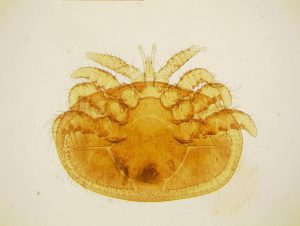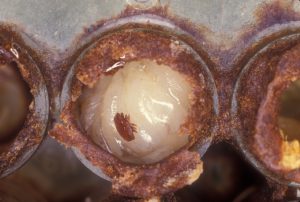Members of the UF/IFAS Honey Bee Research and Extension Laboratory conducted a research project that led to a publication on determining the effective dose for oxalic acid (OA) vaporization in honey bee colonies. Below is a summary of the research as well as a link to the full publication.
Background: Varroa destructor is a dangerous pest of the western honey bee. Varroa can vector and transmit many deadly viruses that can possibly result in colony decline. A common Varroa treatment method among beekeepers is the use of the natural compound, OA. Historically, the most common method of OA application is through the dribble method where beekeepers dissolve OA into sugar water and trickle or spray the solution onto adult bees. However, application via vaporization is becoming more common, and it involves heating OA dihydrate crystals inside a closed hive until the crystals become liquid, then continuing to heat them until they become gaseous.
Purpose: The purpose of this research was to compare how different amounts of OA applied via vaporization effectively reduces the infestation rate of the honey bee pest Varroa destructor.

Key findings: In general, colonies that received the highest dose of OA via vaporization (4 g) had lower Varroa infestations than those that received lower doses.
- Colonies that received 4 g of OA via vaporization showed significantly lower Varroa infestation rates than those that received 0 g and 1 g
- Repeated applications of 2-4 g of OA via vaporization significantly decreased mite load
- The current label rate of 1 g OA per brood chamber was ineffective at reducing Varroa populations, even after repeated applications
- No significant negative impacts on colony health were detected at any dosage, including the repeated dosage of 4 g OA

Significance: One of the reasons Varroa is difficult to control is because it has developed resistance to many chemical treatments. Currently, the legal amount of 1 g of OA per brood chamber in a honey bee colony has not shown to adequately control Varroa populations. Beekeepers are struggling to control this pest and more research must be conducted to evaluate the efficacy of this treatment in tandem with other treatments.
To read this publication, visit: https://www.tandfonline.com/doi/full/10.1080/00218839.2021.1877447
This blog post was written by UF IFAS Honey Bee Lab volunteer Brian Chiang and revised by Amy Vu and Dr. Cameron Jack.
Jack, C.J., van Santen, E., Ellis, J.D. 2021. Determining the dose of oxalic acid applied via vaporization needed for the control of the honey bee (Apis mellifera) pest Varroa destructor. Journal of Apicultural Research, 60(3): 414 – 420. https://doi.org/10.1080/00218839.2021.1877447 .
 2
2
